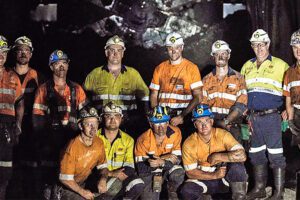What happened?
Incident 1: At a coal mine site two coal mine workers suffered electric shocks from an engine driven welding machine.
Incident 2: Over a 24 hour period, five industrial blower fans powered from an engine driven welding machine auxiliary power supply failed in service. Insulation failure point in Incident 1
How did it happen?
Incident 1. The site’s investigation identified that failure of insulation on the auxiliary output winding allowed 268 Volts AC to appear between the negative terminal of the welder and earth.
Incident 2. The site’s investigation found the blower fans were being fed from an engine driven welding machine auxiliary power supply at a frequency of 60 Hertz while the fan motors were labelled as rated at 50 Hertz.
Comments
Incident 1.
• The ‘introduction to site’ process included insulation resistance tests between the welding and auxiliary power windings. Originally 50 M?; subsequent tests after the incident found that it had degraded to 188?.
• Welding activities were not being carried out at the time of the incident.
• The welding machine was imported by a hire company and lacked compliance certification against Australian or International Standards AS/IEC 60974.1.
• Mines Safety Bulletin 16 has additional information on control of purchased or hired equipment.
Incident 2.
• A review of engine driven welding machines on site found both OEM types all had an auxiliary power output frequency of 60 Hertz. All machines had markings identifying this output frequency, while some, including the machine in this incident, also had additional warning labels on individual socket outlets.
• If equipment is supplied at 60 Hertz while not rated for this frequency, it may overheat, motor may burn-out and / or equipment may over-speed.
Recommendations:
1. Ensure the segregation between auxiliary power circuits and welding circuits on welding machines meets appropriate safety standards.
2. Ensure that welding machine testing includes insulation resistance checks of the welding and auxiliary power windings.
3. Review site power generating equipment to confirm operational power frequencies.
4. Ensure appropriate control measures are in place to manage the risk of operating equipment at incompatible supply power frequencies. Higher level controls in the control hierarchy should be implemented.














Add Comment